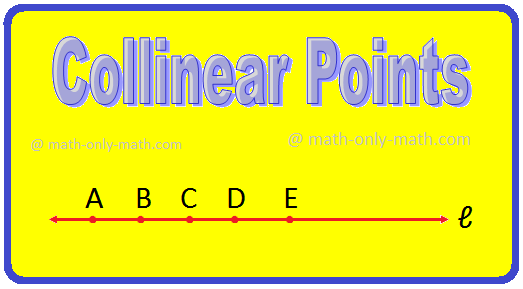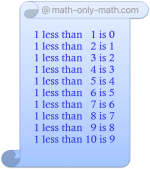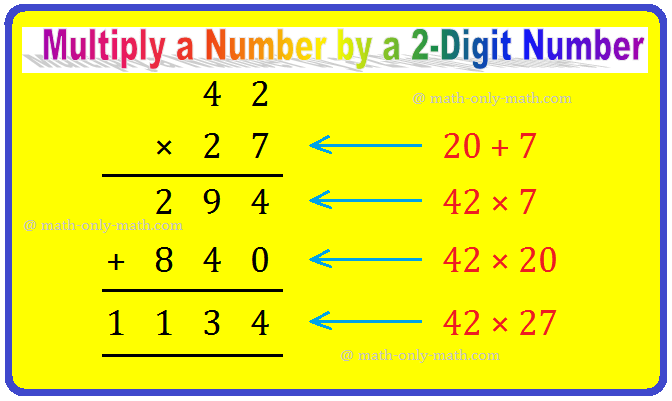Conditions of Collinearity of Three Points
We will discuss here how to prove the conditions of collinearity of three points.
Definition of Collinear Points:
Three or more points in a plane are said to be collinear if they all he on the same line.
Working Rules to Draw Collinear Points:
Step I: Draw a straight line 'ℓ'.
Step II: Mark points A, B, C, D, E on the straight line 'ℓ'.
Thus, we have drawn the collinear points A, B, C, D and E on the line 'ℓ'.
NOTE: If the points do not lie on the line, they are called non-collinear points.
Three points A, B and C are said to be collinear if they lie on the same straight line.
There points A, B and C will be collinear if AB + BC = AC as is clear from the above figure.
In general, three points A, B and C are collinear if the sum of the lengths of any two line segments among AB, BC and CA is equal to the length of the remaining line segment, that is,
either AB + BC = AC or AC + CB = AB or BA + AC = BC.
In other words,
There points A, B and C are collinear iff:
(i) AB + BC = AC i.e.,
Or, (ii) AB + AC = BC i.e. ,
Or, AC + BC = AB i.e.,
Solved examples to prove the collinearity of three points:
1. Prove that the points A (1, 1), B (-2, 7) and (3, -3) are collinear.
Solution:
Let A (1, 1), B (-2, 7) and C (3, -3) be the given points. Then,
AB = √(−2−1)2+(7−1)2 = √(−3)2+62 = √9+36 = √45 = 3√5 units.
BC = √(3+2)2+(−3−7)2 = √52+(−10)2 = √25+100 = √125 = 5√5 units.
AC = √(3−1)2+(−3−1)2 = √22+(−4)2 = √4+16 = √20 = 2√5 units.
Therefore, AB + AC = 3√5 + 2√5 units = 5√5 = BC
Thus, AB + AC = BC
Hence, the given points A, B, C are collinear.
2. Use the distance formula to show the points (1, -1), (6, 4) and (4, 2) are collinear.
Solution:
Let the points be A (1, -1), B (6, 4) and C (4, 2). Then,
AB = √(6−1)2+(4+1)2 = √52+52 = √25+25 = √50 = 5√2
BC = √(4−6)2+(2−4)2 = √(−2)2+(−2)2 = √4+4 = √8 = 2√2
and
AC = √(4−1)2+(2+1)2 = √32+32 = √9+9 = √18 = 3√2
⟹ BC + AC = 2√2 + 3√2 = 5√2 = AB
So, the points A, B and C are collinear with C lying between A and B.
3. Use the distance formula to show the points (2, 3), (8, 11) and (-1, -1) are collinear.
Solution:
Let the points be A (2, 3), B (8, 11) and C (-1, -1). Then,
AB = √(2−8)2+(3−11)2 = √62+(−8)2 = √36+64 = √100 = 10
BC = √(8−(−1))2+(11−(−1))2 = √92+122 = √81+144 = √225 = 15
and
CA = √((−1)−2)2+((−1)+3)2 = √(−3)2+(−4)2 = √9+16 = √25 = 5
⟹ AB + CA = 10 + 5 = 15 = BC
Hence, the given points A, B, C are collinear.
● Distance and Section Formulae
- Distance Formula
- Distance Properties in some Geometrical Figures
- Conditions of Collinearity of Three Points
- Problems on Distance Formula
- Distance of a Point from the Origin
- Distance Formula in Geometry
- Section Formula
- Midpoint Formula
- Centroid of a Triangle
- Worksheet on Distance Formula
- Worksheet on Collinearity of Three Points
- Worksheet on Finding the Centroid of a Triangle
- Worksheet on Section Formula
From Conditions of Collinearity of Three Points to HOME PAGE
Didn't find what you were looking for? Or want to know more information about Math Only Math. Use this Google Search to find what you need.
Recent Articles
-
One More than Numbers upto 10 | Counting One More | Learn 1 more Than
Apr 11, 25 04:09 PM
1 more than means we need to add or count one more number to the given numbers. Here, we will learn counting one more than upto number 10. Examples of counting 1 more than up to number 10 are given as… -
One Less than Numbers upto 10 | Counting One Less | Learn 1 Less Than
Apr 11, 25 04:07 PM
What is one less than? 1 less than means we need to subtract or count one less number of the given numbers. Here, we will learn counting one less than upto number 10. Examples of counting 1 less than… -
Properties of Multiplication and Division of Fractions Worksheet | Ans
Apr 10, 25 03:17 PM
In properties of multiplication and division of fractions worksheet you will get different types of questions based on properties of multiplication of fractional numbers and properties of division of… -
Word Problems on Fraction | Math Fraction Word Problems |Fraction Math
Apr 09, 25 01:44 AM
In word problems on fraction we will solve different types of problems on multiplication of fractional numbers and division of fractional numbers. -
Multiply a Number by a 2-Digit Number | Multiplying 2-Digit by 2-Digit
Apr 08, 25 01:13 PM
How to multiply a number by a 2-digit number? We shall revise here to multiply 2-digit and 3-digit numbers by a 2-digit number (multiplier) as well as learn another procedure for the multiplication of…






New! Comments
Have your say about what you just read! Leave me a comment in the box below. Ask a Question or Answer a Question.